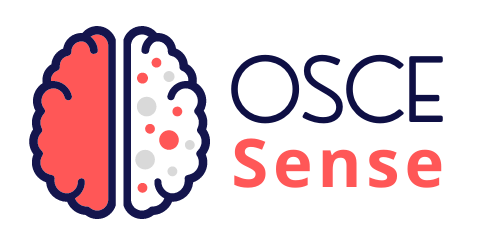
Gen Med Examination 3
Station 3
I can’t feel my face…legs
Candidate Instructions
Setting:
You are a Foundation Year doctor working in AMU. This patient has presented with a leg weakness.
Niamh McManus
Tasks:
1. Perform a peripheral neurological assessment of the patient.
2. Give your preferred diagnosis to the examiner.
3. Give your preferred management plan to the examiner.
Simulated Patient Instructions
Briefing
Please act as the patient and reveal signs and results only as the candidate performs actions or requests tests.
Diagnosis: Guillain Barre Syndrome presenting with peripheral neuropathy and paraesthesia.
You are Niamh McManus aged 21..
You have presented to AMU with leg weakness.
Opening Statement
“Hi Doctor, I’ve had this weakness in my legs for about 4 days, and it’s getting worse. I’ve had to use my Dad’s crutch to help walk and I can’t even work anymore! ”
Appearance and Behaviour
You are anxious about the weakness in your legs. Please see the mark scheme for prompts on symptoms.
If the candidate uncovers any positive findings you can prompt “this is so strange” / “this is not normal for me at all” / “I was fine 4 days ago, running around like nothing was wrong” / “this is scary”
Start the Timer and Begin
Intro
End of Bed Inspection
Inspection
Tone
Power
- Shoulder abduction 5/5 (C5 + axillary nerve)
- Biceps 5/5 (C5)
- Wrist extension 5/5 (C6 + radial nerve)
- riceps 5/5 (C7)
- Finger flexors 5/5 (C8)
- Finger abduction 5/5 (T1 + ulnar nerve)
- Thumb abduction 5/5 (T1 + median nerve)
- Hip flexion 2/5 (L2 + iliofemoral nerve)
- Hip extension 2/5 (inferior gluteal nerve)
- Knee extension 2/5 (L3 + femoral nerve)
- Knee flexion 2/5 (sciatic nerve)
- Ankle dorsiflexion 3/5 (L4 + deep peroneal nerve)
- Big toe extension 3/5 (L5)
- Ankle plantarflexion 3/5 (S1 + tibial nerve)
Reflexes
- Biceps - normal (please note the candidate must elicit a reflex for the mark)
Triceps - normal
Brachioradialis - normal
- Knee jerk - Absent
Achilles - Absent
Babinski - Absent
Sensory
In summary - There is loss in all four modalities of touch in a non dermatomal pattern, bilaterally across the lower limbs. It does not map to a spinal cord level. It is a stocking distribution.
- Upper limbs - Normal bilaterally.
- Lower limbs - Bilateral loss of sensation in a non-dermatomal pattern from mid-thigh downwards (stocking distribution)
- Upper limbs - Normal bilaterally.
- Lower limbs - Bilateral loss of sensation in a non-dermatomal pattern from mid-thigh downwards (stocking distribution)
- Upper limbs - Normal bilaterally.
- Lower limbs - Bilateral loss of sensation in a non-dermatomal pattern from mid-thigh downwards (stocking distribution)
- Upper limbs - Normal bilaterally.
- Lower limbs - Bilateral loss of sensation in a non-dermatomal pattern from mid-thigh downwards (stocking distribution)
Coordination
To Complete the Exam
Examiner Instruction
At this point please direct the candidate to move on to diagnosis.
Diagnosis
Management
Learning Points
Once diagnosis is confirmed the patient would require a ceiling of care decisions (she would likely be for full escalation) and possibly ITU assessment pending results of the peak flow. Showing awareness of this in an OSCE would distinguish a high quality candidate.
GB is a progressive neuropathy that starts peripherally and moves centrally. Monitoring peak flow allows us to estimate if/when patients might need ventilator support, however ventilation is not a perfect treatment as mortality from ventilator associated infection can be significant. GB may be triggered by infection which is why serology may be of value, it is however an autoimmune disease and may be triggered by a wide range of aetiologies.
Submit for Scoring
Tags | Examination | Neurological | Sensory Change | Neuropathy | Peripheral Nerve Exam | Guillain Barre
Station Written by: Dr Megan Burns
Peer Reviewed by: Dr Benjamin Armstrong
Want to suggest an edit?
Comment below and we'll get right to it!
